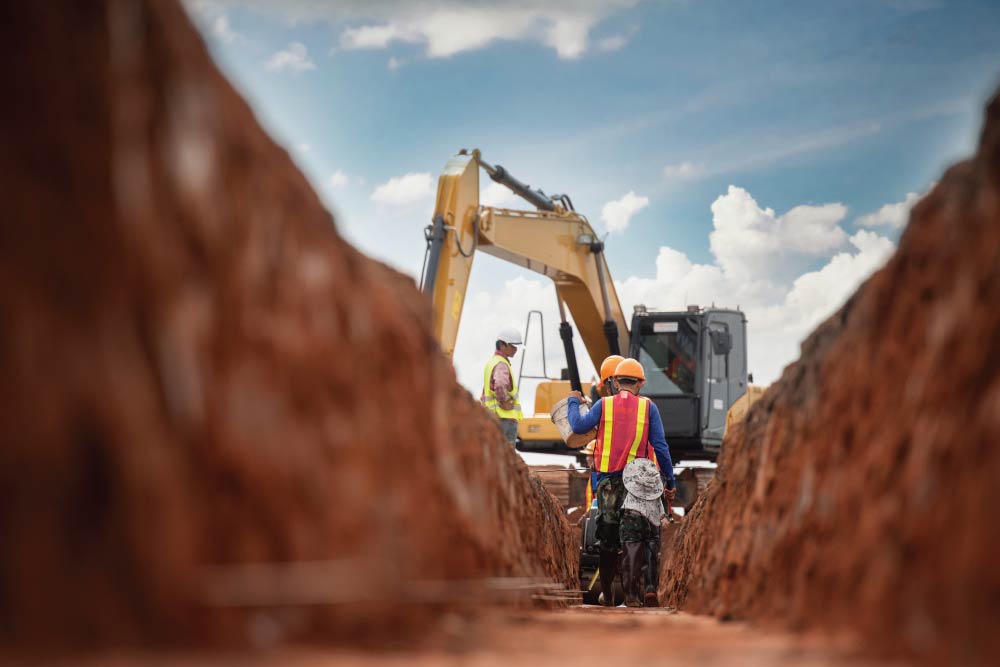
The construction industry is one of the most significant contributors to the UK economy. It’s also one of the most dangerous industries to work in. We hate to break the news, but you must watch your back if you’re involved in construction work. Construction work has more hazards than almost any other type of employment. The good news is that you can eliminate or control most construction site hazards.
Look at any construction site and you’ll find heavy machinery, unstable ground, moving vehicles, heavy loads and hazardous chemicals. And that’s not even the half of it. A construction site is truly a health and safety inspector’s worst nightmare!
In this article, we go over 15 of the most common construction hazards.
How Hazardous Is the UK Construction Industry?
No matter what type of construction work you’re involved in, if you’re on a building site, you face more risks than almost any other worker in the UK.
During 2022-23, some 45 people died as a result of work-related incidents in the UK construction industry, according to figures from the Health and Safety Executive (HSE). That’s a third of all workplace-related deaths in the same time period. This represents a 55% increase year on year.
And that’s not all. The construction industry had 53,000 non-fatal workplace-related injuries during 2022/23.
The construction industry ranks as one of the top three most hazardous UK industries, alongside manufacturing, agriculture, forestry, and fishing. Among these industries, the building sector takes the top place for the most work-related fatalities. It’s not exactly the podium one wants to stand on.
List of Construction Site Hazards
Let’s be honest: if you’re going to set foot on a building site, you will be putting yourself at risk. There’s just no getting around the fact that construction, by its very nature, is nowhere near as safe as sitting in a friendly air-conditioned office or minding a tea cosy shop. (There’s nothing wrong with air-conditioned offices or tea-cosy shops…)
Having a good understanding of what the common construction hazards are is crucial for anyone who works on a building site. If you don’t know what to look out for, you won’t be able to avoid it!
The Most Common Construction Site Hazards Are:
1. Working at Height
The most common type of fatal accident to happen at work is a result of working at height, according to the HSE. Working at height is any situation where you are above ground or floor level and could fall from an edge through an opening, a fragile surface, or from ground level into a hole or opening.
Risk assessments must be done whenever working at height and a systematic work plan must be developed to eliminate or minimise risks. If possible, working at height should be avoided.
2. Moving Objects
Moving objects take the dubious honour of second place among the top causes of fatalities at work. Construction sites are dynamic environments and there are constantly objects in motion. Vehicles, lifting equipment and heavy machinery continuously move throughout a typical working day.
Workers need to take precautions to avoid being struck by moving objects. You should always be aware of your surroundings, not get too close to moving objects, and always wear Personal Protective Equipment (PPE) like a high visibility jacket or vest.
3. Slips, Trips, and Falls
Uneven surfaces, wet surfaces, potholes, debris, random tools and cables everywhere – it’s little wonder that slips, trips, and falls are common on every construction site.
No matter what type of construction work you do, it’s impossible to eliminate these risks, so construction workers must take special care when moving about the site. If there’s a significant risk, report it to a supervisor immediately to clear or deal with it.
4. Noise
Jackhammers, diggers and power drills aren’t exactly quiet things. No one goes to a construction site for its peaceful, soothing and dulcet tones. Construction work is noisy and one of the most common construction site hazards. As well as long-term hearing damage, noise can distract workers from performing a task safely or avoiding an accident.
A comprehensive noise risk assessment should be done on every construction site, and appropriate PPE, e.g. hearing protection, should be distributed to workers.
5. Hand Arm Vibration Syndrome
While it sounds just like the name of an experimental pop group, hand-arm vibration syndrome is another hazard construction workers have to look out for. Also known as HAVS, hand-arm vibration syndrome is a disease that affects the blood vessels, nerves and joints. It’s caused by repeated use of hand-held power tools. Something that most construction workers do pretty often, unfortunately.
Avoiding the risk of HAV means using appropriate protective gear when using any vibratory power tools or heavy-duty ground working equipment.
6. Material and Manual Handling
Picking up something heavy and moving it from one place to another is another standard duty for construction workers. Manual handling can result in serious injuries or musculoskeletal disorders if it’s not done correctly. Workers should be trained in the correct manual handling techniques and use lifting equipment where appropriate.
7. Collapsing Trenches
Buildings that are being demolished or newly dug trenches aren’t stable. Collapsing trenches are another all too common construction hazard. One that can be fatal if precautions aren’t taken.

All trenches should be evaluated for safety before use. They must be regularly inspected before and during the work shift.
8. Asbestos
Asbestos used to be a common building material and can still be found in many older buildings. Materials that contain asbestos can release fibres when broken or damaged. Inhaling asbestos fibres can result in fatal diseases like cancer.
Asbestos is deadly. Suppose the presence of asbestos is suspected on a work site. In that case, workers need to be alerted to where the risk is and a professional brought in to assess the risk. All construction workers should undergo asbestos training.
9. Electricity
It probably won’t come as a shock, but electricity can be very harmful. Touching a live wire or a conducting material can result in a fatal electrical shock. Preventing electrical shocks on a construction site means keeping equipment in good repair and performing a thorough risk assessment.

10. Airborne Fibres and Materials
Asbestos and your mate’s body odour aren’t the only nasty things you could breathe on a construction site. Construction work results in a lot of dust and particles being produced.
Inhale too many of these and you could suffer significant damage to your lungs and internal organs. Avoiding the risks posed by airborne fibres and fine materials requires using PPE such as face masks or air filters.
11. Heavy Machinery and Equipment
Construction work requires the use of all kinds of heavy machinery and equipment. While things like power saws, diggers, industrial sanders and the like are – admittedly – awesome, they’re also a significant hazard to your health.
Training must be provided and regular risk assessments must be completed to avoid injuries or fatalities caused by misusing heavy machinery and equipment.
12. Fire
With sparks from grinders, plenty of electrical equipment and welding tools, and loads of flammable liquids and materials, it’s no wonder that fire is a common risk on construction sites. Fire can start in seconds and tear through an area in minutes.
Fire safety should be a top priority on any construction site. A responsible person must be appointed, the correct risk assessments completed, and adequate fire precautions taken.
13. Confined Spaces
As well as freaking out anyone with claustrophobia, confined spaces like tunnels, pits or tanks are a health hazard. Working in a confined space risks fire, reduced oxygen levels and toxic fumes. Drowning or asphyxiation are also common causes of death in confined spaces.
Working in confined spaces should be avoided if possible. If it’s not avoidable, a careful risk assessment must be undertaken, and emergency arrangements must be implemented.
14. Hazardous Chemicals and Substances
Listing all the hazardous chemicals and substances on a construction site would take years. From corrosive liquids to solvents to carbon monoxide and paints, foams and glues, a construction site is full of things that can burn, poison or hurt you if you touch or inhale them.
Proper precautions must be taken to ensure workers know how to handle and store hazardous chemicals and substances safely. Again, regular risk assessments are crucial to construction site safety.
15. Mental Health Issues
Along with the considerable physical risks of the construction industry, there is a significant risk to construction workers’ mental health. Industry experts have reported that construction workers commit suicide at a rate of four times that of the UK average. Stress, injuries, and cultural norms are driving these types of appalling statistics.
There were an estimated 875,000 cases of work-related stress, depression or anxiety in 2022/23. The current level is higher than the pre-pandemic level.
Removing the stigma around mental health issues isn’t easy, but it can be done. Construction workers should be given access to mental health awareness training and resources to help them should they need it.
Creating a Safer Construction Industry
Building a safer, healthier construction industry in the UK is possible. Providing construction employees access to the correct health and safety training can help them better understand construction site hazards. Health and safety training gives construction workers the skills to look out for themselves and their colleagues.
Help build a better, safer construction industry. Sign up for our Construction Training Courses today.






















































































































































































































































































































































































































































































































































































































































































































































